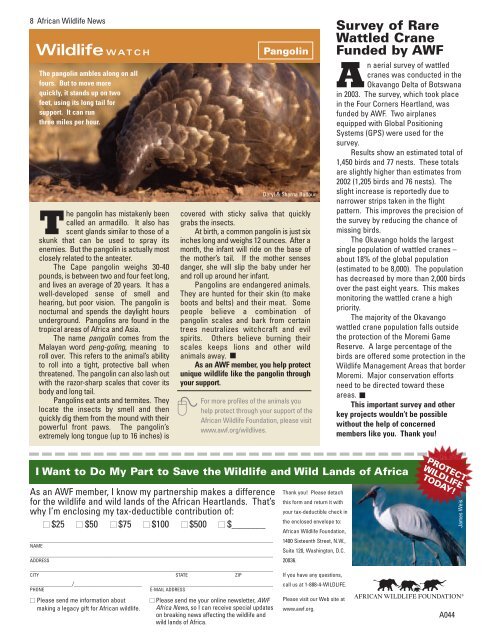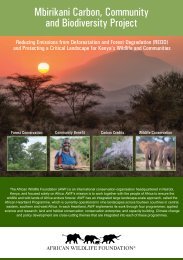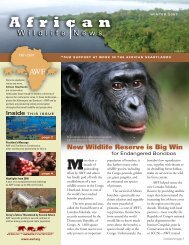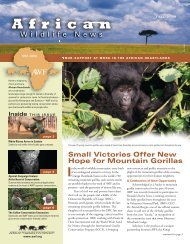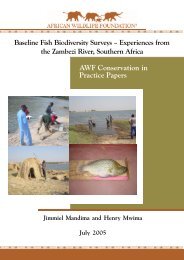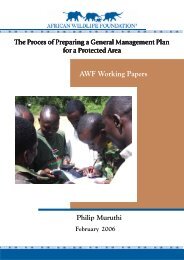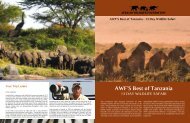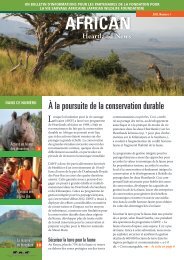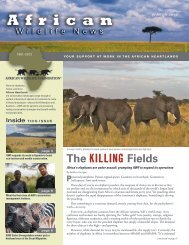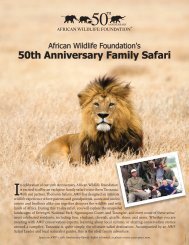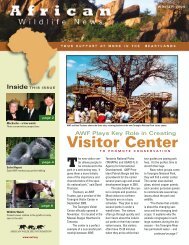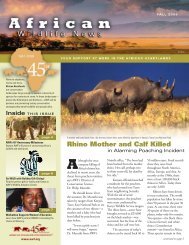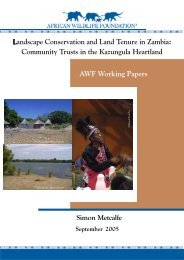Population Increases - African Wildlife
Population Increases - African Wildlife
Population Increases - African Wildlife
You also want an ePaper? Increase the reach of your titles
YUMPU automatically turns print PDFs into web optimized ePapers that Google loves.
8 <strong>African</strong> <strong>Wildlife</strong> News<br />
<strong>Wildlife</strong> WATCH<br />
The pangolin ambles along on all<br />
fours. But to move more<br />
quickly, it stands up on two<br />
feet, using its long tail for<br />
support. It can run<br />
three miles per hour.<br />
The pangolin has mistakenly been<br />
called an armadillo. It also has<br />
scent glands similar to those of a<br />
skunk that can be used to spray its<br />
enemies. But the pangolin is actually most<br />
closely related to the anteater.<br />
The Cape pangolin weighs 30-40<br />
pounds, is between two and four feet long,<br />
and lives an average of 20 years. It has a<br />
well-developed sense of smell and<br />
hearing, but poor vision. The pangolin is<br />
nocturnal and spends the daylight hours<br />
underground. Pangolins are found in the<br />
tropical areas of Africa and Asia.<br />
The name pangolin comes from the<br />
Malayan word peng-goling, meaning to<br />
roll over. This refers to the animal’s ability<br />
to roll into a tight, protective ball when<br />
threatened. The pangolin can also lash out<br />
with the razor-sharp scales that cover its<br />
body and long tail.<br />
Pangolins eat ants and termites. They<br />
locate the insects by smell and then<br />
quickly dig them from the mound with their<br />
powerful front paws. The pangolin’s<br />
extremely long tongue (up to 16 inches) is<br />
Pangolin<br />
Daryl & Sharna Balfour<br />
covered with sticky saliva that quickly<br />
grabs the insects.<br />
At birth, a common pangolin is just six<br />
inches long and weighs 12 ounces. After a<br />
month, the infant will ride on the base of<br />
the mother’s tail. If the mother senses<br />
danger, she will slip the baby under her<br />
and roll up around her infant.<br />
Pangolins are endangered animals.<br />
They are hunted for their skin (to make<br />
boots and belts) and their meat. Some<br />
people believe a combination of<br />
pangolin scales and bark from certain<br />
trees neutralizes witchcraft and evil<br />
spirits. Others believe burning their<br />
scales keeps lions and other wild<br />
animals away.<br />
As an AWF member, you help protect<br />
unique wildlife like the pangolin through<br />
your support.<br />
For more profiles of the animals you<br />
help protect through your support of the<br />
<strong>African</strong> <strong>Wildlife</strong> Foundation, please visit<br />
www.awf.org/wildlives.<br />
Survey of Rare<br />
Wattled Crane<br />
Funded by AWF<br />
An aerial survey of wattled<br />
cranes was conducted in the<br />
Okavango Delta of Botswana<br />
in 2003. The survey, which took place<br />
in the Four Corners Heartland, was<br />
funded by AWF. Two airplanes<br />
equipped with Global Positioning<br />
Systems (GPS) were used for the<br />
survey.<br />
Results show an estimated total of<br />
1,450 birds and 77 nests. These totals<br />
are slightly higher than estimates from<br />
2002 (1,205 birds and 76 nests). The<br />
slight increase is reportedly due to<br />
narrower strips taken in the flight<br />
pattern. This improves the precision of<br />
the survey by reducing the chance of<br />
missing birds.<br />
The Okavango holds the largest<br />
single population of wattled cranes –<br />
about 18% of the global population<br />
(estimated to be 8,000). The population<br />
has decreased by more than 2,000 birds<br />
over the past eight years. This makes<br />
monitoring the wattled crane a high<br />
priority.<br />
The majority of the Okavango<br />
wattled crane population falls outside<br />
the protection of the Moremi Game<br />
Reserve. A large percentage of the<br />
birds are offered some protection in the<br />
<strong>Wildlife</strong> Management Areas that border<br />
Moremi. Major conservation efforts<br />
need to be directed toward these<br />
areas.<br />
This important survey and other<br />
key projects wouldn’t be possible<br />
without the help of concerned<br />
members like you. Thank you!<br />
I Want to Do My Part to Save the <strong>Wildlife</strong> and Wild Lands of Africa<br />
As an AWF member, I know my partnership makes a difference<br />
for the wildlife and wild lands of the <strong>African</strong> Heartlands. That’s<br />
why I’m enclosing my tax-deductible contribution of:<br />
■ $25 ■ $50 ■ $75 ■ $100 ■ $500 ■ $_______<br />
______________________________________________________________________________________<br />
NAME<br />
______________________________________________________________________________________<br />
ADDRESS<br />
_______________________________________________________________________________________<br />
CITY STATE ZIP<br />
_______________/________________________ ____________________________________________<br />
PHONE<br />
E-MAIL ADDRESS<br />
■ Please send me information about<br />
making a legacy gift for <strong>African</strong> wildlife.<br />
■ Please send me your online newsletter, AWF<br />
Africa News, so I can receive special updates<br />
on breaking news affecting the wildlife and<br />
wild lands of Africa.<br />
Thank you! Please detach<br />
this form and return it with<br />
your tax-deductible check in<br />
the enclosed envelope to:<br />
<strong>African</strong> <strong>Wildlife</strong> Foundation,<br />
1400 Sixteenth Street, N.W.,<br />
Suite 120, Washington, D.C.<br />
20036.<br />
If you have any questions,<br />
call us at 1-888-4-WILDLIFE.<br />
Please visit our Web site at<br />
www.awf.org.<br />
PROTECT<br />
WILDLIFE<br />
TODAY!<br />
A044<br />
James Weis


